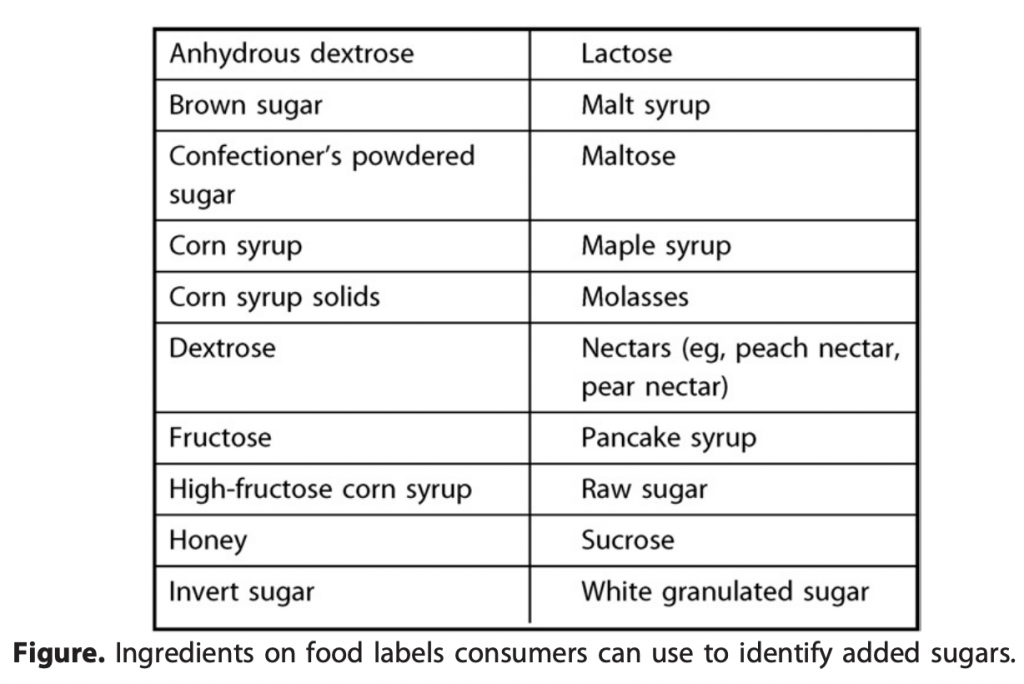
There’s a lot of confusion surrounding nutrition advice in today’s environment and I can understand why. From media to family members and social influencers, there’s no shortage of the amount of (often conflicting) information received on a daily basis.
My goal of these posts is to breakdown topics (that you have requested!) to help make them more understandable. If additional questions remain – feel free to leave them in the comments! I’m always happy to answer.
I struggled whether or not to make this post bunch of quick hits or full of more in-depth information. In the end, I broke it down to include quick hits of information first followed by more in-depth information.
For those that just want a few basics, here you go:
- As with everything, a moderate amount of added sugar intake is not wrong or unhealthful. We have an innate preference for sweetness. Including it in our diets will not harm our health and more often than not will remove guilt associated with enjoying it (leading to a lower likelihood that of eating past the point of comfortable fullness).
- Sugars are naturally occurring in dairy, fruit and vegetables. The body does not differentiate between naturally occurring and added sugar. Typically, foods with naturally occurring sugar offer more nutrients than high added sugar foods.
- The brain’s sole source of fuel and the body’s primary source of fuel is glucose, the simplest form of sugar.
- Substituting non-nutritive sweeteners for sugar has not been shown to reduce weight. The replacement of sugar sweetened foods and beverages with “sugar-free” products should, in theory, reduce body weight given the difference in energy. However, epidemiological studies available on the topic have shown a positive link with body mass index and use of non-nutritive sweeteners. Further research is needed to understand this topic.
- Sugar has not been proven to be addictive. I’m sure you’ve heard rumblings in the media that sugar is addictive, or that it can have the same effect on our brains that hard drugs have. The fact is, the research that has been done to date does not support this and many of the studies done have been done in animals. More high quality, well-controlled research needs to be done to support the validity that a sugar addiction can occur in human beings.
- Kids & Sugar: Feeding Littles (run by an RD & OT) wrote a great post on sugar in kids. I highly recommend reading it if you’re curious about where sugar fits in with kids. I’ve read through it, looked at the sources and fully support the approach they lay out.
For those that would like something a little more in-depth:
There are many different types of sweeteners. The term “sugar” often refers to sucrose, which is derived from sugar cane or sugar beets.
Roles of Sugar:
While often demonized in today’s media, sugar actually plays a number of important food safety & quality roles:
- Adds sweetness to foods (a preference that is innate…it is not abnormal or wrong!)
- Helps to prevent microbial growth by binding water in jams and jellies
- Adds texture, flavor, and color to baked goods
- Aids the growth of yeast for fermentation and non-chemical leavening
- Adds volume to baked goods and jams
- Increases creamy texture & volume in ice creams and frozen novelties
- Enhance crystallization of baked goods and candies.
- Help balance acidity in dishes such as dressings, sauces and condiments.
- Aid in the maintenance of natural color, texture, and shape of preserved fruits.
Breaking Down Different Sweeteners:
In general sweeteners can be broken down into two categories: nutritive and non-nutritive.
Nutritive sweeteners (composed of mono and disaccharides) have many different names: sugar, added sugar and caloric sweeteners. These types of sugars contain carbohydrate and provide energy (~2 calories per gram).
Sugars are naturally occurring in dairy, fruit and vegetables (and can also be added during processing or preparation.
Non-nutritive sweeteners (NNS) have little to no energy and are often referred to as “high-intensity sweeteners” because many are much sweeter than table sugar (sucrose). NNS can replace the sweetness of sugar or energy-containing sweeteners but do not have the same functional properties such as browning, crystallization, or microbial inhibition. Common non-nutritive sweeteners include: acesulfame-K, aspartame, neotame, saccharin, sucralose and stevia.
Sugars commonly found in foods include:
- Glucose: A monosaccharide and the primary source of energy for body cells.
- Fructose: A monosaccharide found in fruit, honey, and some vegetables. In nature, it is linked with glucose as the disaccharide sucrose. Fructose may be used as a nutritive sweetener.
- Galactose: A monosaccharide that occurs in dairy products and some plants.
- Sucrose: A disaccharide that occurs naturally in fruit and vegetables. It is composed of approximately equal parts glucose and fructose and is used as a nutritive sweetener and for its other functional properties.
- Maltose: A disaccharide composed of two glucose units; it is found in molasses and is used for fermentation.
- Corn-based sweeteners: Refers to many products made from corn. They may be composed primarily of glucose, fructose, or any combination of the two.
- High-fructose corn syrup (HFCS): is a mixture of glucose and fructose and is only available to food manufacturers.
- Agave nectar: A nutritive sweetener that contains fructans, oligosaccharides of fructose and glucose, and monosccharides of fructose and glucose.
What Counts As Sugar?
Below are common ingredients you may see on food labels that are considered “added sugars:”

There are other added sugars not recognized by FDA as ‘ingredients’ (so you won’t necessarily see them on the ingredient list) which include cane juice, evaporated corn sweetener, fruit juice concentrate, crystal dextrose, glucose, liquid fructose, sugar cane juice, and fruit nectar.
Carbohydrates & Sugars
While many people think about “carbs” as bread and pasta – they actually encompass much more. The carbohydrate group is made up of grains, fruits, vegetables and dairy. It is recommended that 45% to 65% of our daily energy come from carbohydrates (a minimum of 130 g/day for children and adults). This recommendation is based on the average minimum amount of glucose used by the brain. Going lower than this amount can put your brain at risk of not having enough fuel. Therefore, avoiding or cutting out fruit, vegetable and dairy carbohydrates in order to lower your sugar intake is not recommended.
Sugar Addiction
There have been some studies focusing on whether or not refined sugars, even if part of foods, are addictive due to its linkage to cravings, binge eating, and obesity.
Addiction, by definition is, “a psychological dependence and is a cognitive as well as physical condition.” In order to qualify as dependent or addicted to a substance, you must meet any 3 of the following criteria in 1 year:
- You require more of the substance to achieve the same effect
- You experience withdrawal
- You find you need larger amounts of the substance or need to take it for a longer period than intended
- You have a persistent desire for the substance or an inability to reduce or control its use
- Much of your time is spent seeking/consuming the substance or recovering from its effects
- Use of the substance interferes with important activities
- Use of the substance continues despite adverse consequences
A 2016 literature review on food and sugar addiction found little evidence to support sugar addiction in humans. It’s more likely that the behaviors observed occur from infrequent access to these highly palatable foods, not the neurochemical effects of sugar.
According to the AND position paper, “the literature is complex. It does not always focus on added sugars alone but includes all foods and is often studied within the context of binge eating behaviors.” Thus, more research is needed to determine the validity of sugar addiction in humans.
I hope this helps clear up some of the questions you had regarding sugars. I tried to touch on everyone’s individual questions but if I missed something, just let me know.
The best advice I can offer you when it comes to nutrition advice is to always seek information from qualified experts. It can be tempting to take what you read on social media or hear from friends or family members and run with it – but remember, there’s a lot of misinformation out there (even from healthcare professionals!). I encourage you to always take what you read and ask a trusted professional about it before putting it into practice.
Reference:
2
Very informative article – thank you!
You’re so welcome! Glad to hear it was helpful 🙂